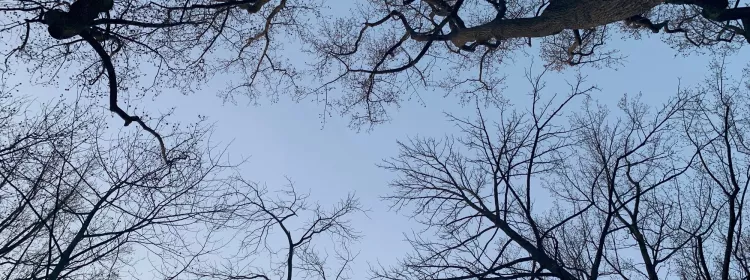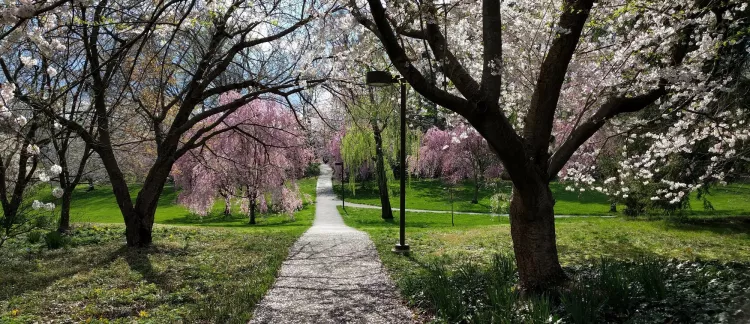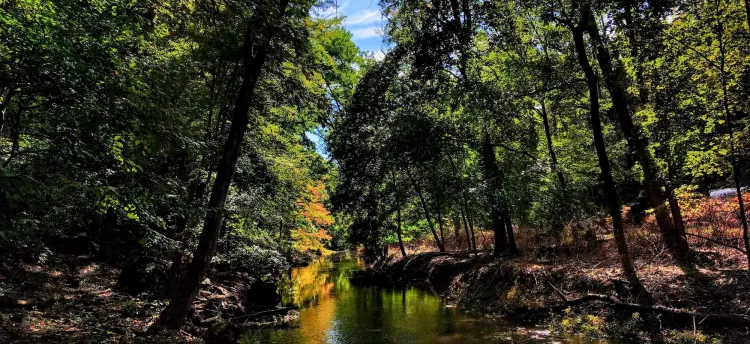- Water Management

Swarthmore’s Environmental Sustainability Framework sets ambitious goals for water management in buildings. One key target aims for management of on-site runoff for the 98th percentile storm event using low-impact development techniques and green infrastructure.
In an effort to mitigate and manage stormwater runoff, the College has implemented a variety of projects and processes, including:
- Installation of porous pavement, rain gardens, infiltration beds, and underground infiltration systems that help to absorb rainwater;
- Installation of green roofs, totaling approximately 31,000 square feet, that absorb rainwater while also providing natural habitat;
- Collection of stormwater runoff in large cisterns, which is then used for landscape irrigation; and
- Development and maintenance of a biostream behind McCabe library that helps to collect rainwater as a natural feature of the landscape.
Another key target in the Environmental Sustainability Framework calls for reducing potable water consumption by 40-50% compared to a baseline performance level in new or renovated buildings.
To meet this target, all dormitory bathrooms have low-flow shower heads and most laundry units on campus are high-efficiency models. For new construction projects, aggressive water use reduction efforts, including grey-water reuse, are considered with the 40-50% consumption target in mind.
- Campus as Arboretum

The campus of Swarthmore College also serves as the grounds of the Scott Arboretum, a public garden of ideas and suggestions, displaying some of the best trees, shrubs, perennials and annuals for growing in the Delaware Valley. Founded in 1929, the Arboretum now has more than 100 award winning plant collections and stunning displays throughout campus. The Arboretum is open to the public year-round, free of charge, from dawn to dusk.
The Scott Arboretum has an exceptional blog, Garden Seeds, which is a wonderful resource for local gardeners. If you are interested in exploring the Arboretum but unable to visit campus, you can take a virtual tour of the gardens here.
The Scott Arboretum and the Grounds and Horticulture Department work together to minimize campus pesticides and herbicide use. Integrated pest management (IPM) is the preferred means of treating the campus grounds, and is used on 400 of the College’s 425 acres. Swarthmore’s IPM plan includes monitoring of diseased plants, damage thresholds, use of natural predators and cultural practices to reduce pests, reduction or elimination of plants in the collection that are prone to insects and/or diseases, and as a last resort, using the least toxic pesticide.
Since 2010, the College has transitioned towards organic lawn care. In 2017, nearly 7 acres of lawns, including Parrish Beach, were actively managed without the use of inorganic fertilizers and chemical pesticides, fungicides and herbicides.
- Crum Woods Stewardship

The Crum Woods encompasses 220 acres of native forest adjacent to the developed portion of the Swarthmore College campus. The Woods contain walking trails and provides recreational opportunities for the Swarthmore College community as well as campus visitors. In addition to recreation, the Woods are often used as a classroom or as a site for research; 35 courses in 12 departments make use of the Woods as a teaching tool.
Crum Woods management is overseen by the Crum Woods Stewardship Committee. Since 2018, members of the Committee have worked with Grounds & Horticulture staff to implement the Crum Woods Restoration & Stewardship Plan.
The Crum Woods are open to the public year-round, free of charge, from dawn to dusk. Trail maps and a Crum Woods Biodiversity Guide are maintained by the College for public use.
- Land Acknowledgement
Swarthmore College exists on Lenapehoking, the name given to the land by the Lenape, the Indigenous people of the area around the Delaware River. Lenapehoking was more than just the physical landscape; it included the flora, fauna, and the Lenape themselves. The Office of Sustainability recognizes that a truly sustainable community cannot exist without knowing the history of our land and learning from Indigenous voices, and this acknowledgement serves to remind ourselves to center these perspectives in what we do.
The College’s official land acknowledgement, along with guidance on using it, is available here.





